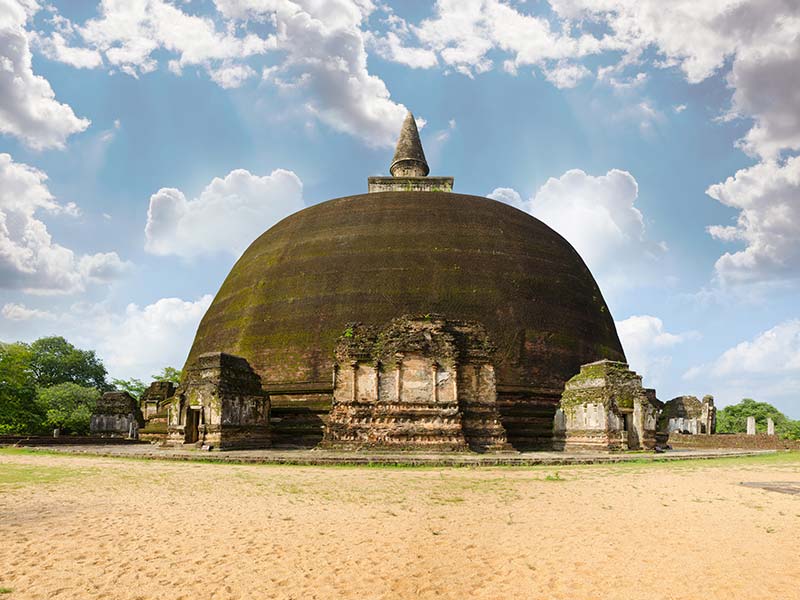Rankoth Vehera is the largest and most important stupa in the whole of Polonnaruwa. At least fifty-five meters in height and standing on a large platform, it is today preserved wonderfully in its original brick form. In form, it is supposed to look somewhat similar to the ancient Anuradhapura stupa of Ruwanweliseya and in fact, it was even referred to as such, although the names Ratnavalli Stupa and Rankoth are even more applicable.
The latter name means “Golden Pinnacle,” after the summit of the building itself. Rankoth Vehera was constructed under the sponsorship of the foreign monarch Nissankamalla. He came from east India, and made numerous fictitious claims for the Sri Lankan throne, going so far as to add that Vijaya, the legendary first king came from his hometown of Kalinga, modern-day Orissa rather than from the north.
He also tries to equate himself with the kings preceding him. One of the other claims he made to strengthen himself was to deny the farming caste any chances of kingship, a rather trivial and foolish action as they had no real ability to dethrone the kshatriya ruling class.
During his nine-year reign during the 12th Century AD he clearly felt like a foreigner, despite having taken the country’s throne. One of the other claims he used was that made was that the previous ruler Parakramabahu invited him to be a provincial governor.
Indeed while he set up a number of inscriptions all over the country on his tours, none of them can be taken literally for it was merely a move to strengthen his position on the Polonnaruwa throne.
Almost nothing he has said is true, in other words.
Among his masterpieces in Rankoth Vehera, and while it is seemingly meant as a slight imitation of the earlier Ruwanweli, it does have its differences. For example, the spire of the stupa is incredibly thin as it looks skywards from its post atop the large, somewhat more domelike bell, the garbha of the building. In its conception, this brick building is simple, and today it is about thirty-three meters tall, although it has been heavily restored by later kings and it is calculated that the original height might have been over fifty to sixty meters, among the largest in the country and the largest one built after the 4th Century AD, when Mahasen constructed his colossal Jetavanarama.
The simplicity of the Polonnaruwa stupa is clear in the utter lack of any ornate vatadage around it. While the rectangular base in between the spire and the bell, the hataras kotuwa, is richly detailed with what appear to be solar carvings that can be made out even from afar. The lack of protective structures is more probably due to the practical impossibility of having such an immense roof over it. But there are the customary vahalkada, or altars for making offerings in the four corners of the centerpiece. Therefore it is more of a scaled-up knockoff of the earlier Kirivehera if naught else. These altars are engraved with the figures of dwarfish, demonic or semi-divine beings called vamanas as well as the heads of elephants.
On the whole, Rankoth Vehera lies outside the Alahana zone, instead being part of a monastic complex all to its own. There are the remains of tiny brick funerary stupas all around it, simple mounds lacking the incredible detail and majesty of the main centerpiece towering above them. There is also a colonnaded structure, consisting of the ground floor of part of the monastery itself. This particular monastery seems to have been built in the form of a Panchavasa, as per the ancient text Manjusri Vastuvidya Sutra. A Panchavasa is actually a concept in architecture and is a building that consists of an image house, a stupa, a place for the Bo tree, an audience hall as is probably preserved presently, and rooms in which the clergy would have stayed.
Written by Vasika Udurawane for Travel Lanka Compass



0 Comment